The Frasassi Caves are a must-see sight in Italy for their beauty and impressive subterranean chambers.
Easy to reach by train and car and less than three hours away from Rome and Florence, you will find this karst cave system in the Central Italian region of the Marche.
The Frasassi Caves are rich in whimsical formations and are dotted with tiny crystal clear lakes. Their entrance is in the Gola di Frasassi – a steep gorge cut by the river Sentino. The gorge is part of the Gola della Rossa and Frasassi Regional Nature Park.
The karst cave system stretches through the base of the Monte Valmontagnana. It includes the Cave of the River and the Big Cave of the Wind and its full name in Italian is Grotta del Fiume – Grotta Grande del Vento di Frasassi. It’s commonly known as the Frasassi Caves.

The Frasassi Caves are open for guided visits which are held regularly throughout the day. With an expert guide at the helm, visitors are taken deep into the earth’s bosom through several subterranean chambers of the Big Cave of the Wind. This was discovered by chance in 1971 and its first chamber – the Ancona Abyss – is so cavernous that, they say, the Duomo of Milan could fit comfortably in it.
Entering the Frasassi Caves is like finding yourself in a dream world. Enormous stalactites, stalagmites, and stalagnates have built wondrous creations to which the explorers of the caves have given suitably imaginative names. Here you have the Sword of Damocles, the Small Niagara Falls (pictured below), the Witches’ Castle, and also the Pancetta Slice and the Lard Slice. The last two are thin and almost translucent stalagmites respectively in a pale pink and a pure white colour.
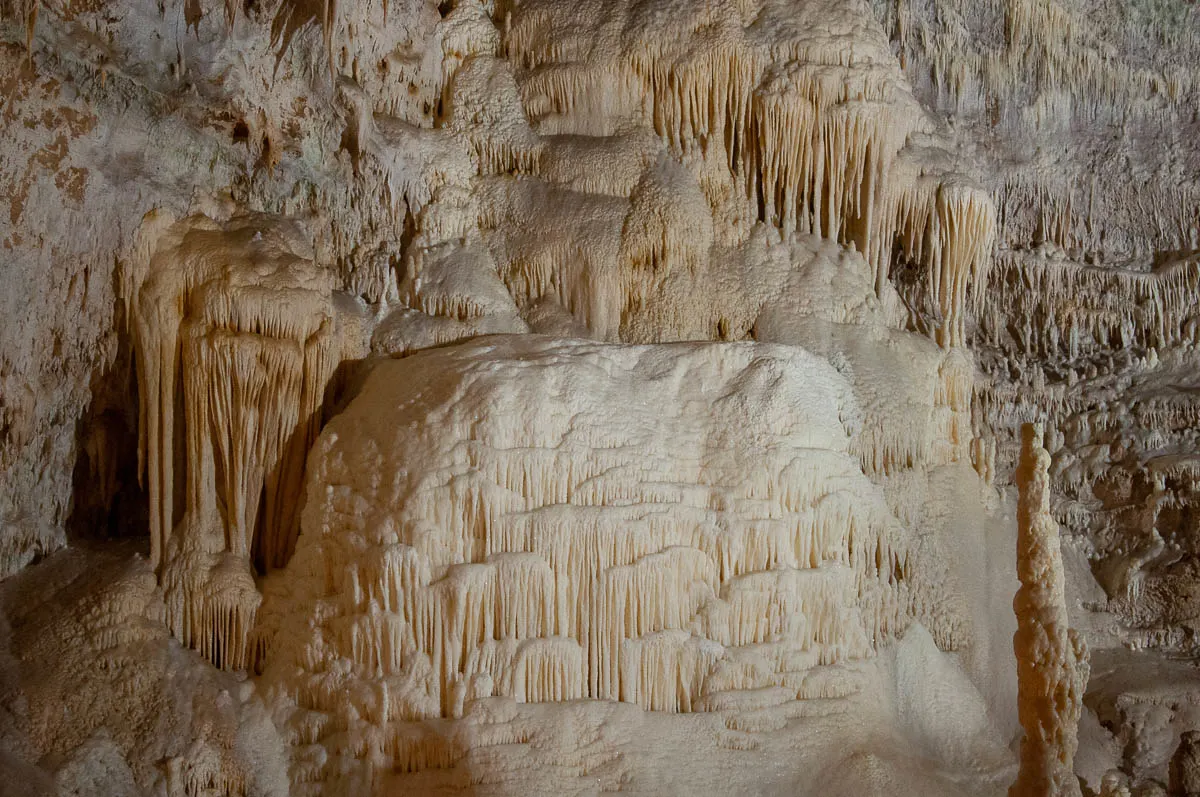
Visiting the Frasassi Caves is a great experience. The tourist itinerary follows an easy to navigate path that is about a kilometre and a half long and has a few steps. There are also two options for the adventurous at heart to explore the caves even deeper led by a skilled spelunking guide. In addition, the area around the Frasassi Caves is rich in curious sights and things to do.
So, if you are looking for a new and exciting destination in Italy to discover and explore for yourself, a place where you can marvel at natural wonders both under- and overground, look no further than the Frasassi Caves.
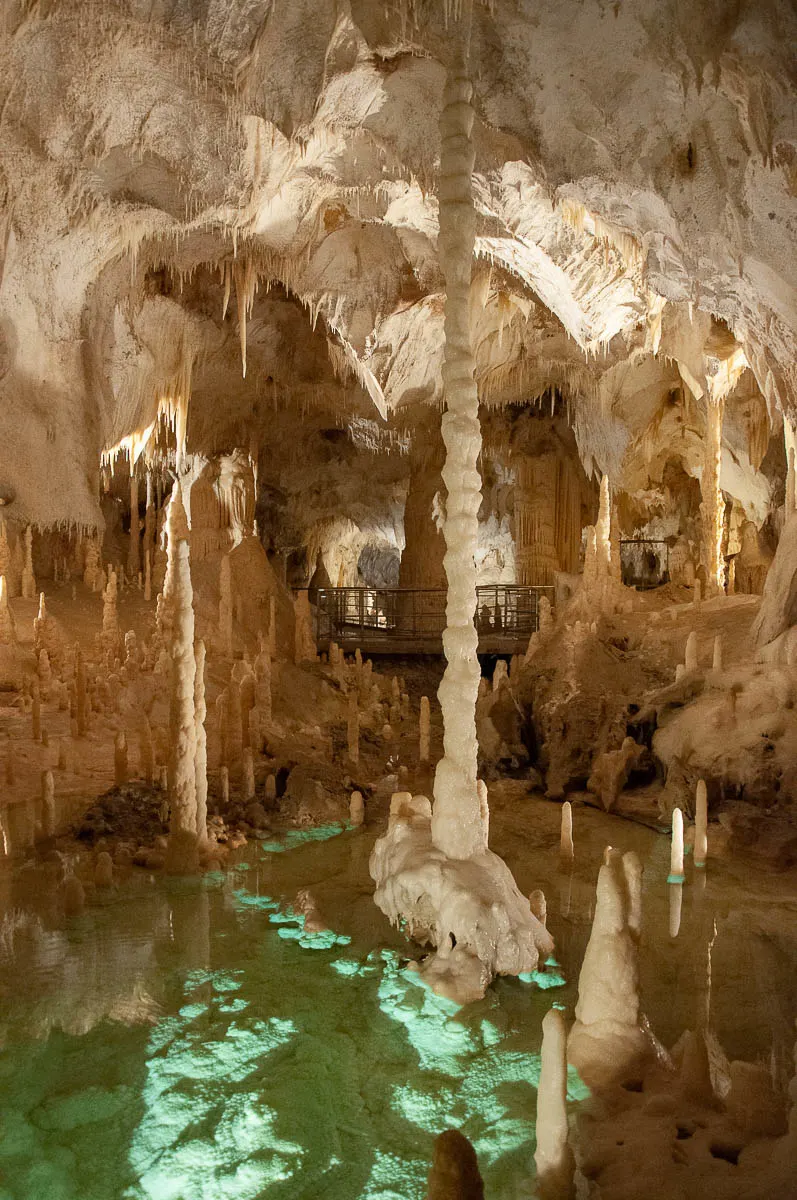
In this blog post today, I will give you exhaustive details to help you plan your visit to this unique place. You can see it on a day trip to remember or you can choose to spend longer in the area, it’s completely up to you. From an overview of the history of the Frassasi Caves to how to visit them and how to prepare for your time inside the chambers, from transport options to reach the caves to other places of interest in the adjacent area, everything is covered herewith.
Read on!
Italy’s Stunning Frasassi Caves – A Must-See Wonder of Nature
Why Visit the Frasassi Caves, Italy
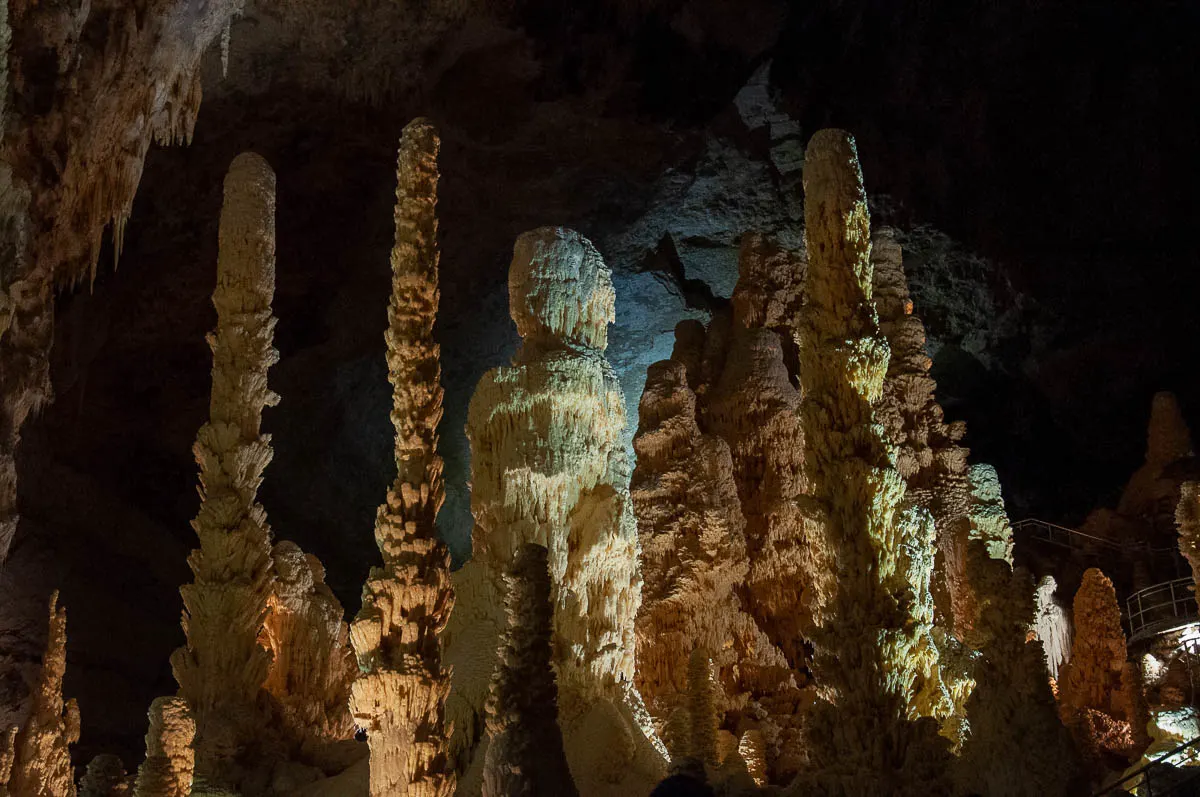
The underground karst system of Italy’s Frasassi Caves extends for 30 km on eight geological levels. It is one of the largest and most fascinating subterranean routes in Italy and Europe. Guided visits, held daily at regular intervals, introduce tourists and adventurers to the wonders of the underground world.
Visiting the Frasassi Caves will also give you a chance to see for yourself a beautiful corner of the Marche – Italy’s most underrated region. Lush, crossed by dramatic gorges, and dotted with over one hundred other caves and rock cavities, it offers countless opportunities to hike, rock climb, and get close to nature in many different ways.
The area around the Frasassi Caves has been inhabited since prehistoric times. A number of important and curious artefacts have been discovered here relating to magical-religious rituals and funerary rites held by prehistoric and protohistoric communities inside the local caves. The most significant finding is the Frasassi Venus – a small figure carved out of a stalactite and representing a woman with emphasised fertility traits. It is between 20,000 and 28,000 years old.
Small local museums offer a first-row view of the various layers of history that make this part of Italy so interesting to visit. Centuries-old walled villages and churches conserve traditions that stretch back to the Middle Ages. A famous spa centre offers treatments at the place where the Ancient Romans took baths in the local sulphur-rich waters.
All in all, travelling to the Frasassi Caves is a great excuse to escape the large cities and the tourist magnets and to discover for yourself the real, authentic Italy.
Very Abridged History of the Frasassi Caves, Italy
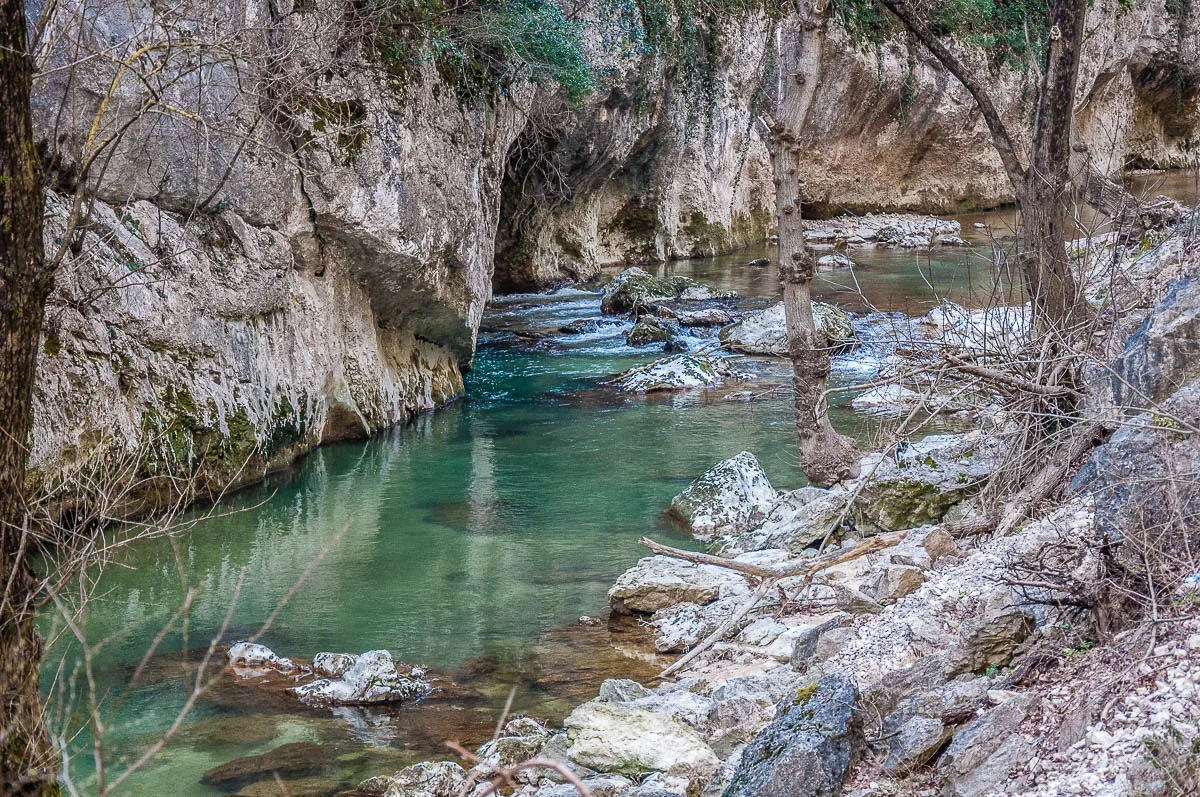
The formation of the Frasassi Caves started millions of years ago when sulphurous waters coming from the depths of the earth penetrated into the limestone rocks of what nowadays is the Gola di Frasassi (known in English as the Frasassi Gorge). There, they mixed with the cold bicarbonate waters of the River Sentino flowing into the rocks from above through cracks and faults. The waters – rich in minerals – dissolved the limestone and created the large subterranean voids over a period that lasted many thousands of years.
The area of the Frasassi Gorge is rich in caves and cavities. While some of them have been known to the local population for centuries, the Cave of the River and the Big Cave of the Wind which comprise the Frasassi Caves complex are a somewhat more recent discovery.
The Cave of the River was discovered first in 1948 through a hole close to the bed of the River Sentino. In 1971, the Big Cave of the Wind was discovered by chance by a speleological group from Ancona – the capital of the Marche – which is about 65 km away from the Frasassi Gorge. The subterranean connection between the two caves was discovered at the end of the same year.
Since then, the two caves came to be known collectively as the Frasassi Caves. Several studies and research projects have been performed there, especially in chronobiology to measure the biological rhythms of people who have spent periods of time without natural light. In the Cave of the River, explorers have found the 13,500 years old skull of a steinbock laid on a low stalagmite with flint and carbon pieces next to it. Researchers think that the skull could have been used in rituals by Paleolithic hunters.
The flora of the Frasassi Caves has also been studied and documented. It’s been established that 67 animal species call the caves home. Among them are dozens of species of bats, the spectacled salamander and the newt.
Due to its stunning environment and somewhat easier access, the Big Cave of the Wind was adapted for tourist visits. A path leading through several of the cave’s chambers was installed with the focus always being on not affecting negatively the cave and not damaging the formations that had taken hundreds of thousands of years to form.
Nowadays, the Frasassi Caves are one of the Marche’s must-see sights and one of Italy’s and Europe’s most beautiful show caves. Since their opening to the general public on 1st September 1974, the caves have been visited by over 12 million people.
What to See in the Frasassi Caves, Italy
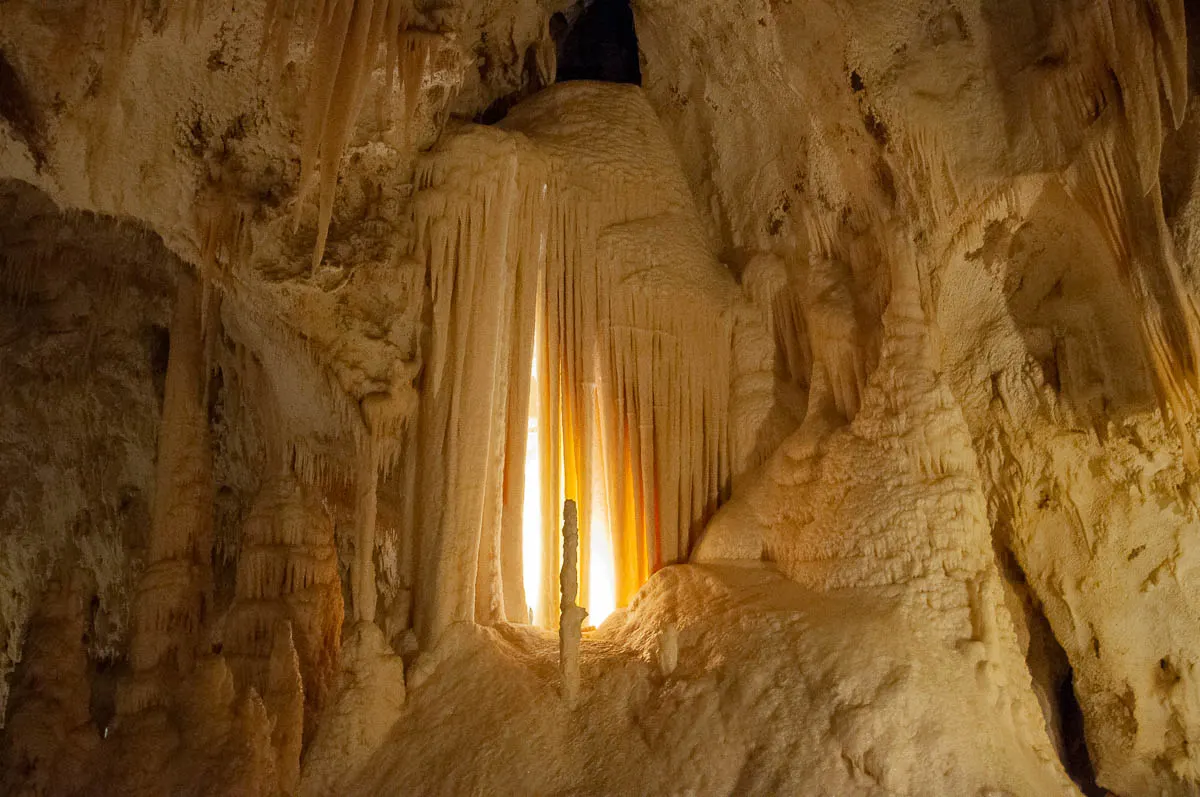
The Frasassi Caves are open to visitors who can choose to follow one of three itineraries inside the subterranean chambers of the Big Cave of the Wind:
- Tourist Itinerary – accessible to people of all ages, this itinerary lasts around 1 h 30 mins and follows a wide path with some steps. Some of the chambers you will see are:
- Ancona Abyss – 180 m long, 120 m wide, and 200 m tall, this immense chamber was the first part of the Big Cave of the Wind that was discovered in 1971 by a group of speleologists from Ancona.
- Hall of the 200 – a corridor that is 200 m long.
- Hall of the Small Candles – dotted with many small cylindrical stalagmites that look like candles.
- Hall of the She Bear – this is where you can see a formation that faintly resembles a bear.
- Infinity Hall – with an irregular circular shape, the first explorers to study this chamber would often get lost trying to find the way out which made them walk in endless circles around the hall.
- Speleo-Adventure Blue Itinerary – aimed at lovers of speleology and those adventurous at heart, this itinerary is two hours long and it’s of low/average difficulty.
- Speleo-Adventure Red Itinerary – again aimed at lovers of speleology and those adventurous at heart, this itinerary is three hours long and it’s of average difficulty.
The prices for the three itineraries differ and you can check the up-to-date price points at this official link. The equipment needed for the speleo-adventure blue and red itineraries is provided on-site and it is included in the cost of the ticket.
All tickets for the Frasassi Caves also include entry to the nearby Speleo-Paleontological and Archaeological Museum in the hamlet of San Vittore and the Museum of Art, History, and Territory in the village of Genga. Click here to learn more about them and the other exciting things you can do in the area.
How to Visit the Frasassi Caves, Italy
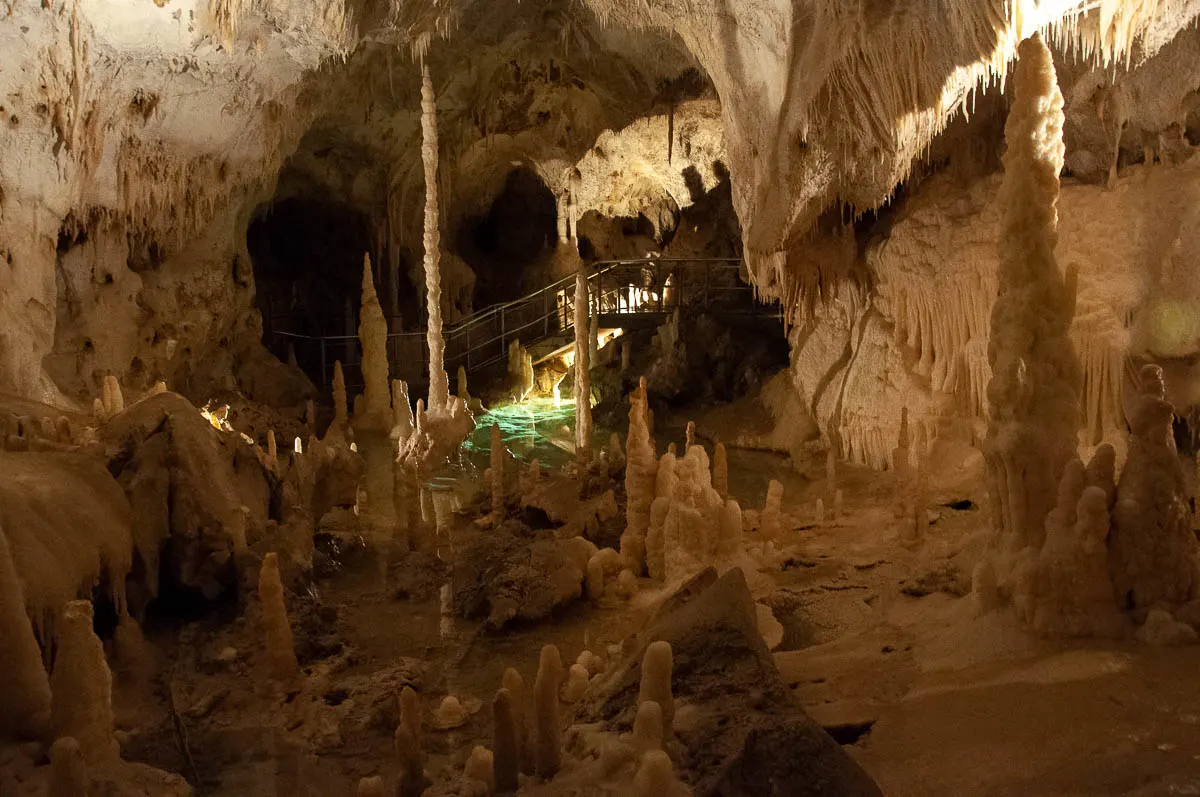
The Frasassi Caves are one of Italy’s most popular and most beautiful show caves. A show cave is a cave that can be accessed by tourists (usually as part of a guided visit) without any special equipment.
You will find the Frasassi Caves in the Central Italian region of the Marche. They are about 65 km away from the region’s capital – the city of Ancona. Distances to Italy’s capital Rome and other large Italian cities are as follows:
- Rome to the Frasassi Caves – about 233 km;
- Perugia to the Frasassi Caves – about 71 km;
- Rimini to the Frasassi Caves – about 141 km;
- Arezzo to the Frasassi Caves – about 149 km;
- Florence to the Frasassi Caves – about 219 km.
You can reach the Frasassi Caves easily both by train and car. This is how to do it:
- By train – get off at the Genga-San Vittore train station on the Rome-Ancona train line. Average travel times from Roma Termini are about three hours and from Ancona – under an hour. The train station is right next to the large car park of the Frasassi Caves’ ticket office. You can buy your train ticket online in advance on the official website – TrenItalia – of Italy’s train operator. To find out how to navigate Italy’s train system, please, refer to the tips and tricks for quick and cheap train travel in Italy at the end of this blog post.
- Car – the Frasassi Caves are on state road SS76 which (together with SS318) leads from Ancona to Perugia. Please, note that there is no parking right by the caves’ entrance. Instead, all personal vehicles must be parked at the large car park around the Frasassi Caves’ ticket office.
Once you reach the Frasassi Caves’ ticket office, you need to buy a ticket. If you have already purchased your ticket online, then you need to present the printout confirming the online payment so that an actual ticket can be printed for you. Tickets are tied to a time slot and you need to be there on time so as not to miss it.
For specific opening times, time slots, and other useful info, please, check the official website of the Frasassi Caves here. You will notice that the number of time slots depends on the season and the day, so you will need to organise your visit accordingly. While visits are possible all throughout the week, still on particular days throughout the year the Frasassi Caves are closed. Make sure that you check the official link provided in this paragraph well in advance in order to avoid disappointment.
During the high season, the Frasassi Caves attract a large number of visitors, so plan accordingly in terms of parking and queueing.
Once you have secured your ticket, a shuttle bus will then take you and all other visitors who have booked the same time slot to the actual entrance of the Frasassi Caves. It’s best to align for the shuttle bus about half an hour before the time slot of your visit. The distance from the car park to the caves’ entrance is about two km.
The guide will meet the group at the caves. You will then enter through the large metal doors, walk through a long concrete corridor, stop for a short talk about health and safety and then through another set of heavy doors, walk into the first chamber of the Frasassi Caves. The guided tour lasts about 75-90 minutes. The guide will take you through the subterranean chambers which are accessible to visitors and will introduce you to the story of the Frasassi Caves, how they were discovered, and what their geology is. The guide will also point the most beautiful and whimsical formations in the caves.
On the way back to the car park from the Frasassi Caves, the shuttle bus stops at the small hamlet of San Vittore. This is where you can see a number of sights like the 11th-century Abbey of San Vittore delle Chiuse and the adjacent Speleo-Paleontological and Archaeological Museum to learn more about the Frasassi Caves and the adjacent area.
You can then easily walk back to the car park from San Vittore and, if you travel by train, to the train station.
What Are Your Personal Impressions of Visiting the Frasassi Caves, Italy
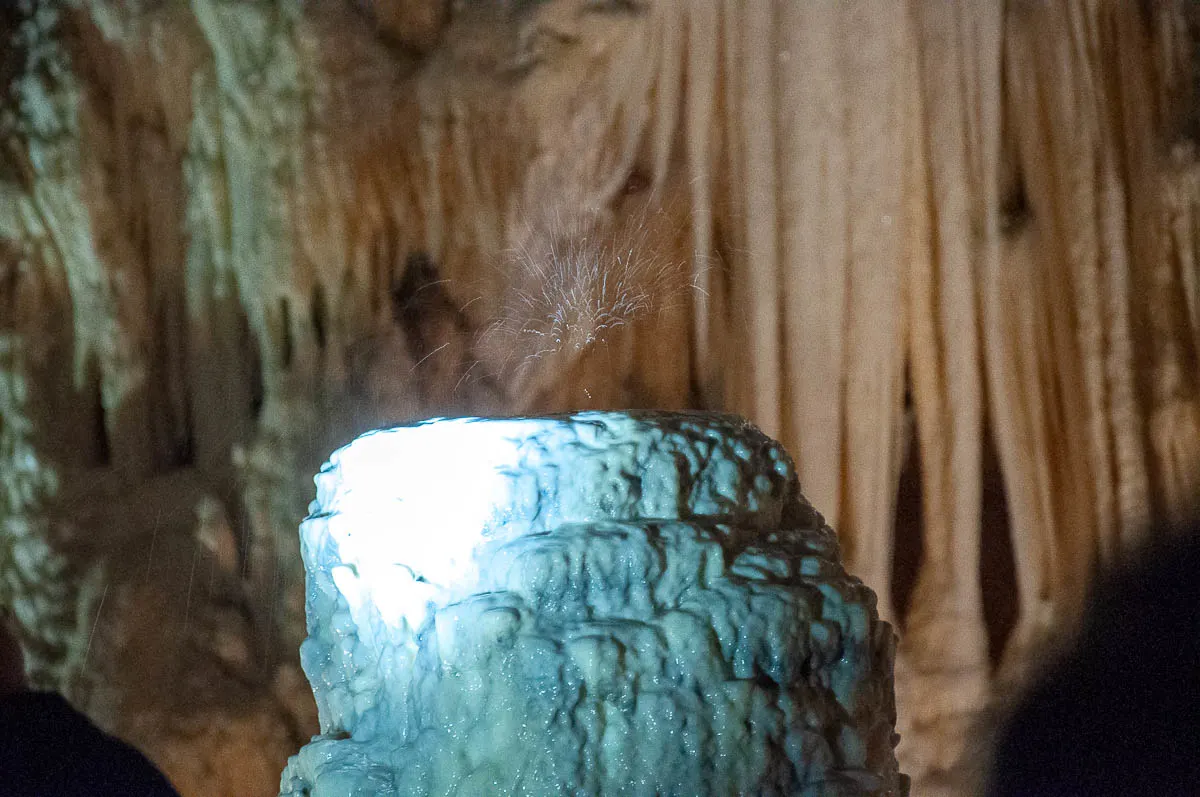
Visiting the Frasassi Caves in the Marche was one of the best travel experiences I had during my six years in Italy.
We travelled to the Marche by car on a four-day long road trip to remember. It was just at the end of winter when nature is starting to awaken yet the days feel sombre and the skies give you the impression that they are about to break into heavy rain at any minute. Perfect weather to escape underground and to marvel at the wonders of nature without fear that you are going to get wet.
As it was outside of the high season, the large parking lot around the ticket office of the Frasassi Caves seemed almost empty. Most of the small shops there that sell all sorts of trinkets and souvenirs were also closed. Yet, there were about forty people on the guided tour which showed how popular the caves are no matter the month and the weather.
The Frasassi Caves are very impressive. The first chamber that the guided tour starts from is the absolutely enormous Ancona Abyss. It feels like a Cathedral of Nature and it is so quiet inside it. It’s a very womb-like environment. I felt like inside a cocoon – safely enveloped and protected from the elements – but at the same time, as the space is so cavernous, it was not a claustrophobic sensation. It’s not surprising that prehistoric people sought refuge in caves. However, they didn’t have the luxury of a wide lit path that we enjoyed walking on during our tour of the Frasassi Caves.
The guide was very engaging and gave us lots of information about the caves – from their formation and discovery to the names of many of the curious stalactites, stalagmites, and stalagnates around us. I especially liked the Dante stalagmite. You can really see the profile of the great Italian poet shaped by nature.
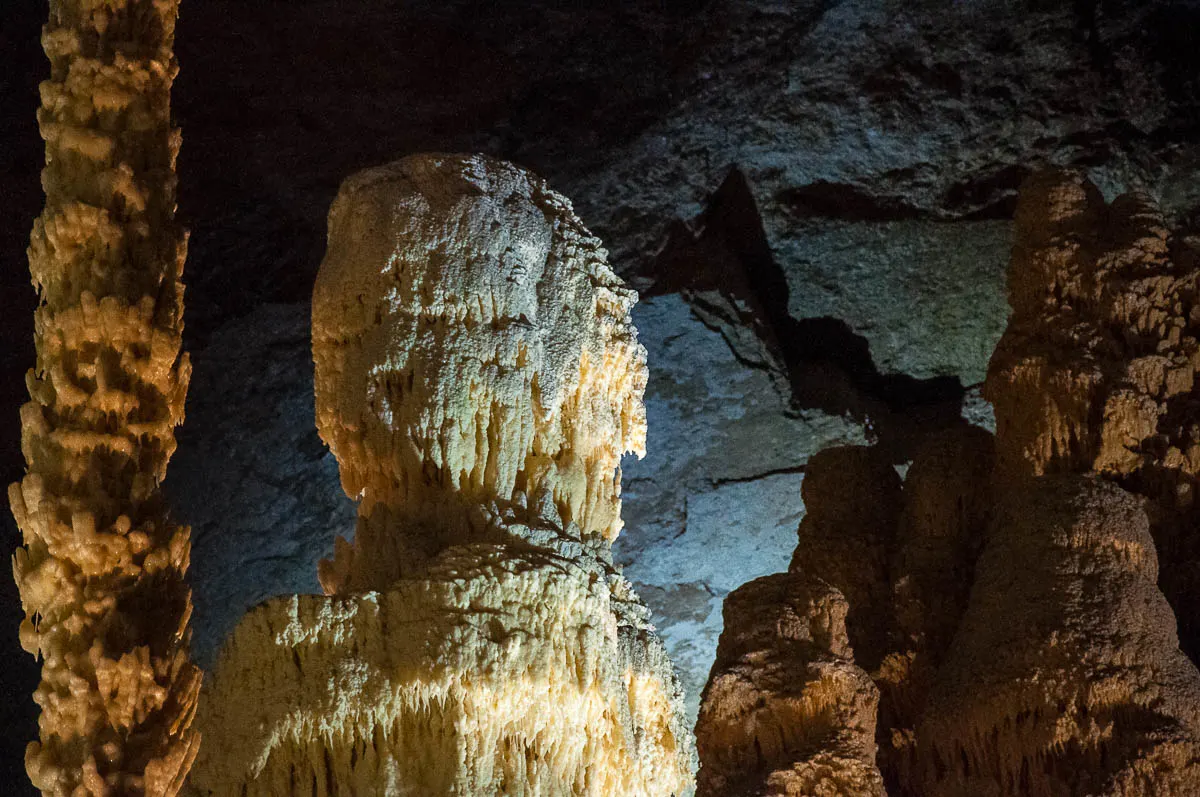
An interesting fact that caught my attention was that for the naked human eye it’s difficult to judge the actual size of the cave formations as there is nothing else inside the cave against which to measure them. So, stalactites and stalagmites that didn’t look that big were in fact dozens of feet tall.
We followed the guide through the caves. The path built for tourist visits is very easy to walk on. There were a few steps along the way but nothing strenuous, really.
The cave chambers were lined with thousands of really beautiful formations. We walked past several crystal clear lakes along the way. They were so beautiful. I felt that I could easily spend hours there just looking at them.
Whimsical shapes caught my eye at every step and turn. At one point, we walked on a long thin bridge with lakes on one side and a long drop on the other. In the dim light, I felt like we were in a charmed kingdom where fairytale creatures steal a peek at you and swiftly hide right before you spot them.
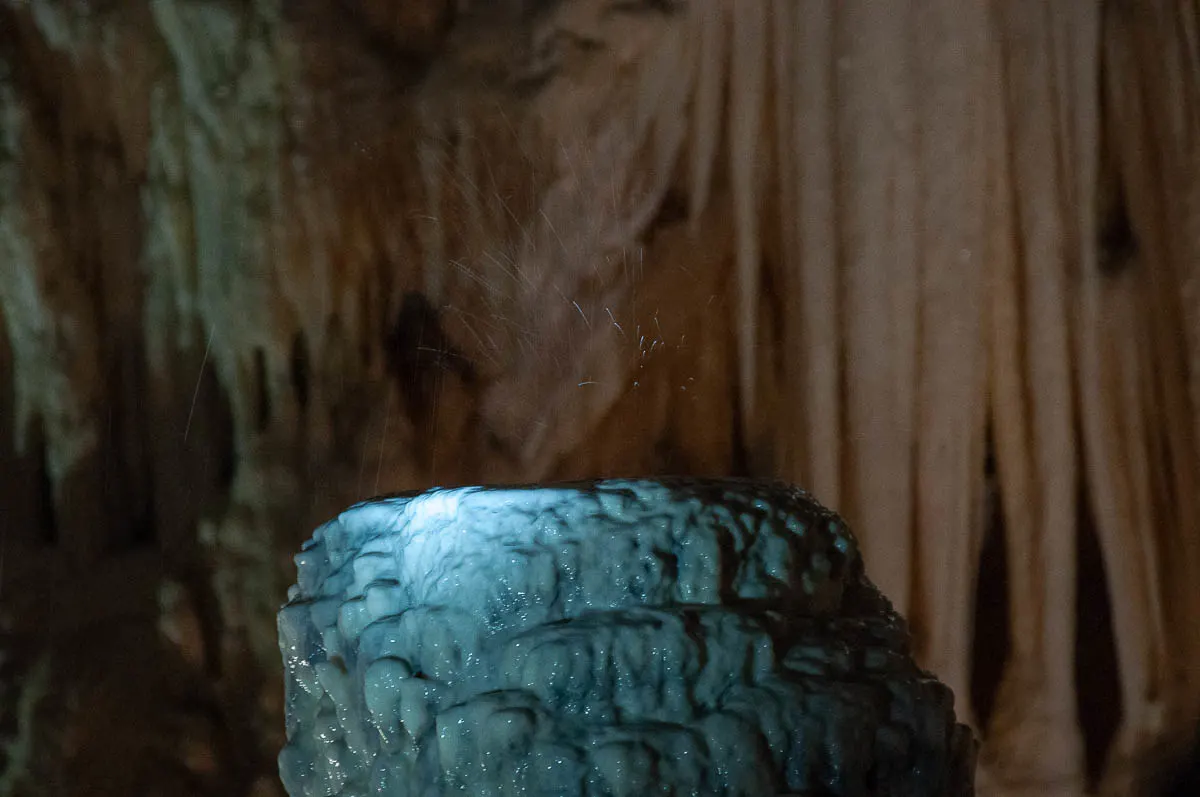
My most favourite thing about the Frasassi Cave is actually something I was able to see only after my visit. While there, I took a photo of a stalagmite and when processing the photos for this blog post, I realised that somehow, in the dim light, I had managed to press the shutter of my camera just as a tiny droplet of water was hitting the surface of the stalagmite.
You can see the firework-like pattern that the droplet had produced. With stalagmites, stalactites, and stalagnates being built over many thousands of years by the minerals in such droplets of water, I was really excited to have captured a photo of one such droplet at work. It’s proof that the Frasassi Caves are an organism in constant development. Visiting the caves truly is seeing nature at work.
Practical Tips About Visiting the Frasassi Caves
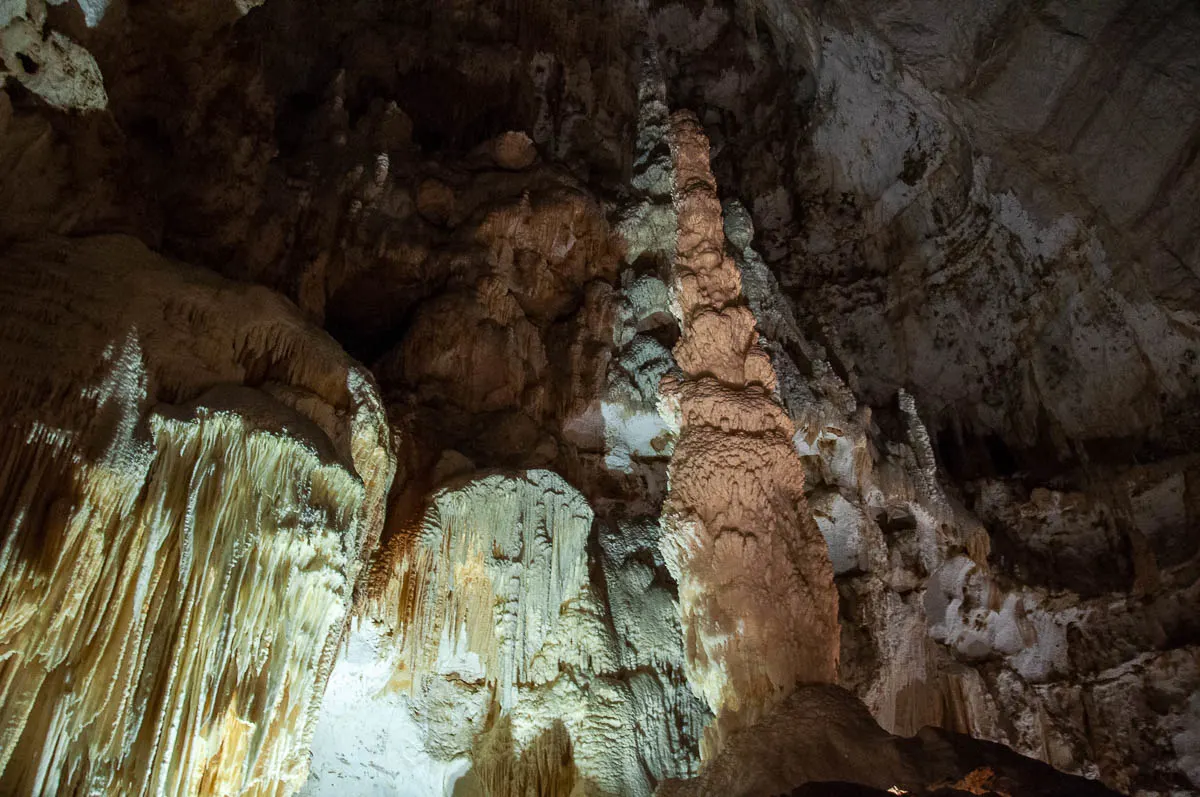
Here are some first-hand tried and tested practical tips to make your visit to the Frasassi Caves as enjoyable as possible.
Dress appropriately – The temperature inside the Frasassi Caves is a constant 14 degrees Celsius irrespective of the weather outside. If you are visiting in summer, bring a warm piece of clothing in case you feel a bit cold during the visit.
Wear comfortable shoes – you will be walking on a flat path with some steps for about an hour and a half. The light is dim and there may be wet patches on the floor here and there. Wearing comfortable shoes will make your time inside the Frasassi Caves a much more pleasant and safe experience.
Follow the guide’s instructions – The guides are there to show you the Frasassi Caves’ wonders but also to make sure that both the group and the cave remain safe during the visit. As such, please, follow strictly his or her instructions at all times.
Don’t touch – It is strictly forbidden to touch the formations inside the Frassasi Caves. It has taken nature an incredible amount of time to create the wonderful and whimsical stalactites, stalagmites, and stalagnates you see there. Interfering with them in any way may irreversibly damage them. Even a light touch may be really harmful to them as the oils in the human skin may make it impossible for the tiny drops of water which make the cave formation grow continue to cling or flow at their usual place and speed. This way, the growth of the formation will be forever changed or even stunted. Our hands also bring outside bacteria into the cave environment and dirt on fingers can stain or change the colour of cave formations.
Mind the dim light – The light inside the Frasassi Caves is dim with spotlights trained on some of the most beautiful formations. Your eyes will adjust quickly but you may need to mind your step during the guided visit.
Don’t eat and drink inside the caves – This is not allowed for the safety of the visitors and the caves themselves. There are food kiosks and restaurants within an easy reach from the ticket office’s parking lot. Also, plan toilet breaks accordingly before and/or after your visit to the Frasassi Caves.
Observe photo etiquette – Double check with the guide that the taking of photos and/or videos is allowed. When I visited the Frasassi Caves, it was allowed but things change. If photos/videos are OK, then make sure you don’t disturb the whole group and the guide’s work when taking photos. In any case, tripods are not allowed. In addition, don’t stick your camera or your phone over the railings and, definitely, don’t lean over the railings yourself while trying to take a photo. The drop on the other side may be significant or your outstretched arm may collide with a cave formation thus forever damaging it.
Don’t lag behind the group trying to take photos without people in them. One of the guide’s tasks is to keep the group together for safety reasons. When you are taking a photo or a video inside the caves, make sure that your children are not left unsupervised in the meantime. Someone – another parent, partner or relative – needs to be with them at all times, making sure that they are safe and comfortable.
Everyone in the group will want to take photos and videos (if allowed) inside the caves. The environment is beautiful and unusual and people get excited about capturing it all. Don’t push other people aside trying to get the best shots first. Don’t tut-tut when other people are taking their time at the exact spot you are angling for. Beware of steps and wet surfaces. Don’t walk with the camera in front of your face. Don’t ask people to move away so that you don’t have anyone in your photos’ backgrounds.
Remember that you all have paid an entrance fee and have the same right to enjoy the cave environment respectfully. Also, you are in a group of different nationalities in an underground space. Do you want the tempers to flare or to leave a bad impression?!
Here, I hasten to add that all photos you see here were taken by me with maximum respect and full observance of the above words.
What Else to do Near the Frasassi Caves, Italy
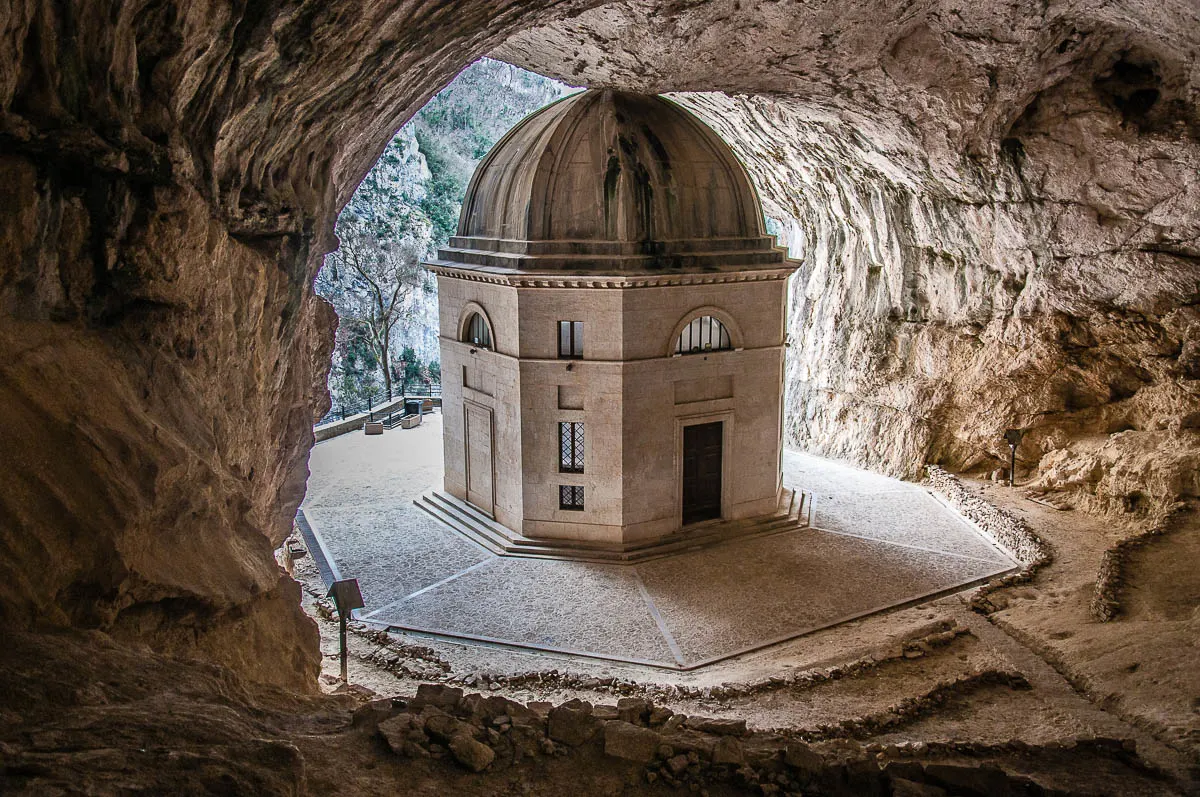
The area around the Frasassi Caves is at the crossroads of culture and adventure. There are dozens of things to do there – hikes, museums, churches, medieval villages, sights of natural beauty, spa procedures, a thousand years old hermitage, and even an octagonal temple inside a cave mouth.
For an exhaustive list of the many exciting things to do in the vicinity of the Frasassi Caves, please, click on this blog post:
In Conclusion
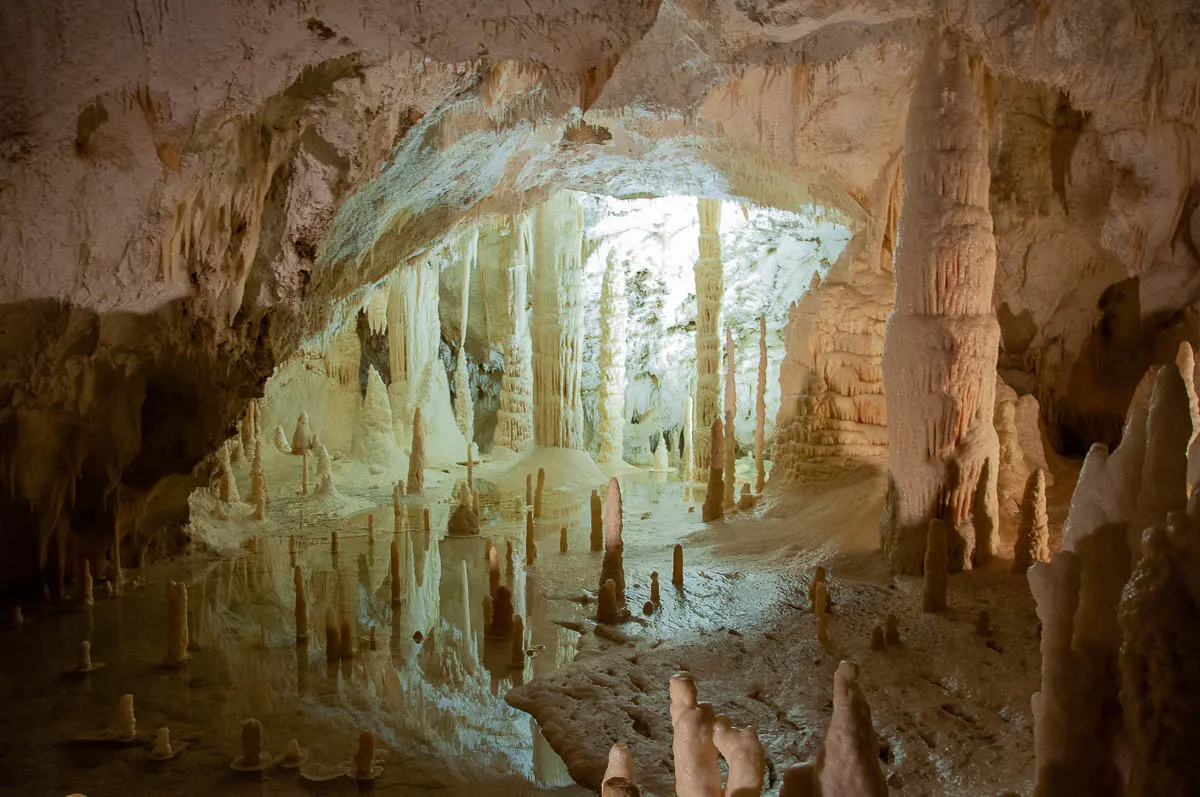
The Frasassi Caves are one of Italy’s and Europe’s most famous and beautiful show caves. You will find them in the Central Italian region of the Marche.
The caves are open to visitors and offer three different itineraries of increasing difficulty to follow through their underground chambers. Come here if you want to experience a different side to Italy and to enjoy the country’s stunning nature.
The above blog post provides exhaustive details to make your visit to the Frasassi Caves, Italy as smooth and enjoyable as possible. It shows you the beautiful cave environment that you can expect to see for yourself when there and gives you lots of first-hand tried and tested tips on how to organise your visit.
I hope that this information will galvanise you to put the Frasassi Caves in Italy at the top of your travel wish list.
Enjoy your visit to the Frasassi Caves!
More Helpful Links
- 3 Caves in Europe to Easily Explore with Your Family This Year
- 13 Best Things to Do Around the Frasassi Caves, Italy
- Marche, Italy – 6 Reasons to Visit Italy’s Most Underrated Region
- Visiting the Postojna Caves in Slovenia with a Toddler – Tips for Parents
- Grotte del Caglieron – Caves, Waterfalls, and Cheese – A Great Day Out in the Veneto, Northern Italy
- The Painted Caves of Rubbio, Italy – Where Art Meets Nature
Thank you for reading! Please, leave me a comment, pin the image below or use the buttons right at the top and at the end of this blog post to share it on social media.
For more useful information like this, please, like my blog’s page on Facebook and subscribe to my strictly no-spam newsletter.

